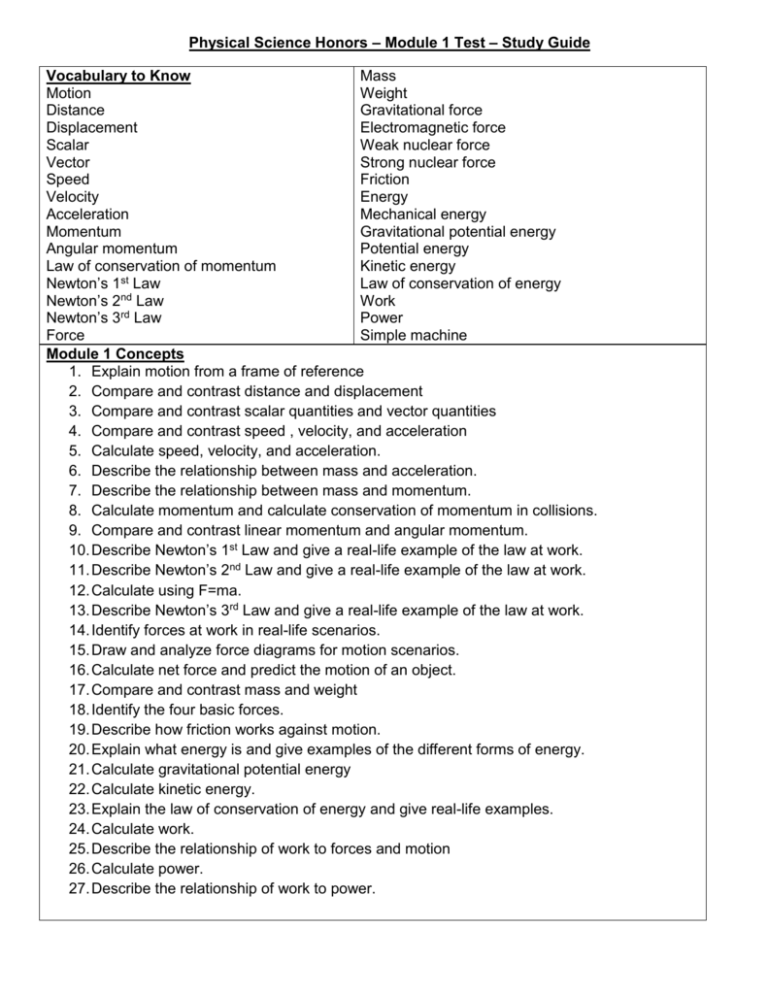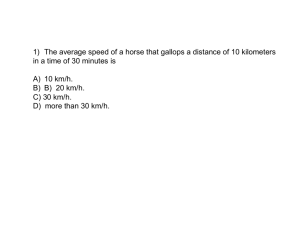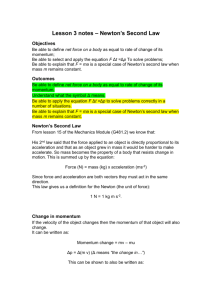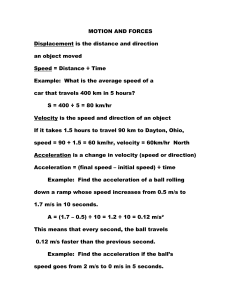PS_Module 1 Study Guide
advertisement

Physical Science Honors – Module 1 Test – Study Guide Vocabulary to Know Mass Motion Weight Distance Gravitational force Displacement Electromagnetic force Scalar Weak nuclear force Vector Strong nuclear force Speed Friction Velocity Energy Acceleration Mechanical energy Momentum Gravitational potential energy Angular momentum Potential energy Law of conservation of momentum Kinetic energy Newton’s 1st Law Law of conservation of energy Newton’s 2nd Law Work rd Newton’s 3 Law Power Force Simple machine Module 1 Concepts 1. Explain motion from a frame of reference 2. Compare and contrast distance and displacement 3. Compare and contrast scalar quantities and vector quantities 4. Compare and contrast speed , velocity, and acceleration 5. Calculate speed, velocity, and acceleration. 6. Describe the relationship between mass and acceleration. 7. Describe the relationship between mass and momentum. 8. Calculate momentum and calculate conservation of momentum in collisions. 9. Compare and contrast linear momentum and angular momentum. 10. Describe Newton’s 1st Law and give a real-life example of the law at work. 11. Describe Newton’s 2nd Law and give a real-life example of the law at work. 12. Calculate using F=ma. 13. Describe Newton’s 3rd Law and give a real-life example of the law at work. 14. Identify forces at work in real-life scenarios. 15. Draw and analyze force diagrams for motion scenarios. 16. Calculate net force and predict the motion of an object. 17. Compare and contrast mass and weight 18. Identify the four basic forces. 19. Describe how friction works against motion. 20. Explain what energy is and give examples of the different forms of energy. 21. Calculate gravitational potential energy 22. Calculate kinetic energy. 23. Explain the law of conservation of energy and give real-life examples. 24. Calculate work. 25. Describe the relationship of work to forces and motion 26. Calculate power. 27. Describe the relationship of work to power. Calculations 1. A baseball is thrown a distance of 20 meters. What is its speed if it takes 0.5 seconds to cover the distance? 2. Sarah backstrokes at an average speed of 8 meters per second, how long will it take her to complete the race of 200 meters length? 3. Bonnie Blair set the world record for women’s speed skating in 1995, with an average speed of 12.9 m/s. How far would Blair have traveled at this speed in a time of 5.00 minutes? 4. The fastest crossing of the Atlantic Ocean by an ocean liner was made on July 7, 1952. The ship, the S.S. United States, traveled 4727 km east by northeast in 3 days, 10 hours, and 40 minutes. Assume that the ship had traveled the same speed, but directly east. What would the velocity of the S.S. United States be in kilometers per hour? 5. A skater increases her velocity from 2.0 m/s to 10.0 m/s in 3.0 seconds. What is the skater’s acceleration? 6. While traveling along a highway a driver slows from 24 m/s to 15 m/s in 12 seconds. What is the automobile’s acceleration? (Remember that a negative value indicates a slowing down or deceleration.) 7. A 4.88 kg bowling ball is moving east at 2.41 m/s strikes a stationary 0.95 kg bowling pin. After the collision, the pin is moving east at 5.19m/s. What is the velocity of the bowling ball? 8. A 10 kg mass is moving at 6 m/s and it hits a 3 kg mass moving at 3 m/s. After the collision, the 3 kg mass is moving at 9 m/s. How fast is the 10 kg mass moving? 9. How much force is needed to accelerate a 100 kg mass at a rate of 2.5 m/s 2? 10. What is the mass of an object that is accelerating at a rate of 25 m/s2 and is using 15 N of force? 11. 5N 5N 8N 10 N 12. 13. You serve a volleyball with a mass of 2.1 kg. The ball leaves your hand with a speed of 30 m/s. The ball has ______________________ energy. Calculate it. 14. A baby carriage is sitting at the top of a hill that is 21 m high. The carriage with the baby weighs 12 N. The carriage has ____________ energy. Calculate it. 15. A car is traveling with a velocity of 40 m/s and has a mass of 1120 kg. The car has ___________energy. Calculate it. 16. A cinder block is sitting on a platform 20 m high. It weighs 79 N. The block has _____________ energy. Calculate it. 17. 18. A weight lifter lifts a set of weights a vertical distance of 2 m. If a constant net force of 350 N is exerted on the weights, what is the net work done on the weights? 19. How much work does Bobby perform in pushing a 35 N crate a distance of 4 meters? 20. A horse performs 15000 joules of work pulling a wagon for 20 seconds. What is the horse's power? 21. A box is pushed across the floor for a distance of 5 meters with a force of 50 N in 5 seconds. Calculate the power.






